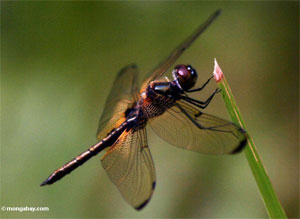Dragonfly migration similar to that of birds
Princeton University
May 10, 2006
University of Utah study reveals another contributor to polar warming
Scientists have discovered that migrating dragonflies and songbirds exhibit many of the same behaviors, suggesting the rules that govern such long-distance travel may be simpler and more ancient than was once thought.
The research, published in the May 11 Biology Letters, is based on data generated by tracking 14 green darner dragonflies with radio transmitters weighing only 300 milligrams — about a third as much as a paper clip. Green darners are among the 25 to 50 species of dragonflies thought to be migratory among about 5200 species worldwide.
The team of researchers that made the discovery, led by Princeton University’s Martin Wikelski, tracked the insects for up to 10 days from both aircraft and handheld devices on the ground. They found that the dragonflies’ flight patterns showed many similarities to those of birds that migrate over the same regions of coastal New Jersey.
“The dragonflies’ routes have showed distinct stopover and migration days, just as the birds’ did,” said Wikelski, an associate professor of ecology and evolutionary biology. “Additionally, groups of both birds and dragonflies did not migrate on very windy days and only moved after two successive nights of falling temperatures. We saw other similarities as well, which makes us wonder just how far back in Earth’s history the rules for migration were established in its animals.”
 With their semi-aquatic habitat, dragonflies are proving to be useful indicators of habitat quality above and below the water surface. Tellingly, of the 564 dragonfly and damselfly species so far assessed by the organization, nearly one in three are threatened, including nearly 40% of endemic Sri Lankan dragonflies. |
|
According to fossil records, dragonflies appeared about 285 million years ago, predating the first birds by about 140 million years.
Wikelski said that the findings could also be an important demonstration of how to track small animals over great distances, a technique that could be useful in agriculture and ecological management.
“These small transmitters could enable us to track animals from space all around the globe if satellites were available,” Wikelski said. “Though nearly everyone has heard of animal migration, we actually know very little about how animals move. It could tell us a lot about the way species respond to climate change and other disturbances. Because the economies of many nations are still largely agrarian, a better understanding of how, say, locust swarms travel could assist us with managing both local agriculture and the world economy that hinges upon it.”
This article is a modified news release from Princeton University.